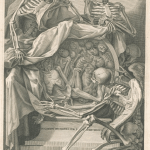

BERNARDINO GENGA (1620-1690). Anatomia per uso et intelligenza del disegno; ricercata non solo su gl’ossi, e muscoli del corpo humano… Rome: Domenico de Rossi, 1691.
An authoritative anatomist and surgeon in Rome, Genga stressed the importance of solid anatomical knowledge for the surgeon. Genga wrote the first book devoted entirely to surgical anatomy which remained a widely used manual for fifty years.
Genga was one of the first Italians to accept Harvey’s theory on the circulation of the blood, but Genga also maintained that the discovery was made by Colombo and Cesalpino before Harvey. The parts played by those two Italian investigators and anatomists in the unfolding of the facts of circulatory physiology have been a point of study and argument among medical historians.
This large atlas contains 40 magnificent full-page engraved plates depicting the human figure in various poses, with and without dissection. Some of the full-figure plates are engraved renditions of celebrated antique statues in Rome. The plates, probably engraved by François Andriot, were intended primarily for the use of painters and sculptors, and they are still considered to be one of the best collections for the use of student artists. The text is by Giovanni Maria Lancisi.
You may view this book in the John Martin Rare Book Room, Hardin Library for the Health Sciences. Make a gift to the Hardin Library for the Health Sciences by donating online or setting up a recurring gift with The University of Iowa Foundation.